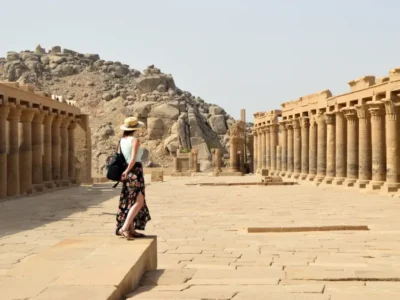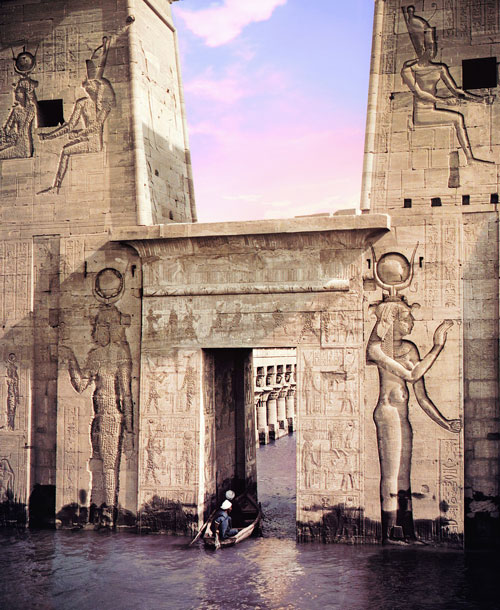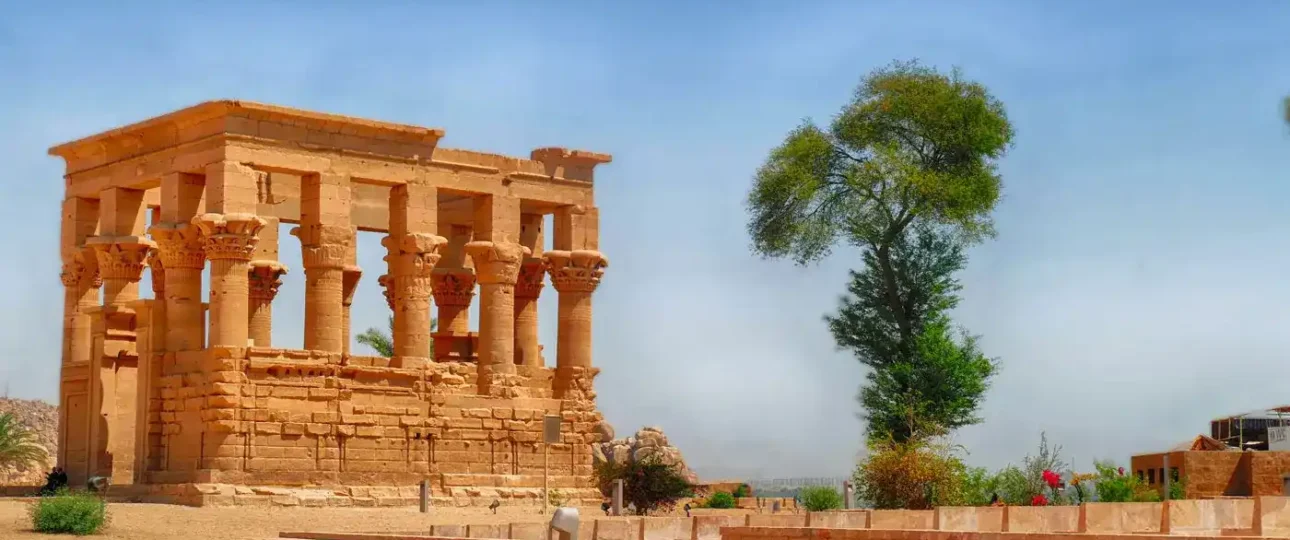Philae Temple: Unraveling the Sacred Island of Aswan
Nestled on the picturesque island of Philae in Aswan, the Philae Temple stands as a captivating testament to the enduring beauty of ancient Egyptian architecture and religious devotion. Once the center of the worship of the goddess Isis, this magnificent temple complex offers a glimpse into the spiritual significance and cultural heritage of ancient Egypt. In this article, we embark on a journey to explore the wonders of the Philae Temple, delving into its historical context, architectural splendor, religious significance, and the enduring allure that continues to attract travelers and history enthusiasts from around the world.
Historical Context of the Philae Temple The original Philae Temple was constructed during the Ptolemaic dynasty, around 380 to 362 BC. However, it underwent several expansions and additions during the Greco-Roman period, showcasing a fusion of Egyptian and Hellenistic architectural styles.
The Cult of Isis
The Cult of Isis was one of the most popular and widespread mystery cults in the ancient Mediterranean world. It originated in Egypt, but by the 2nd century BCE, it had spread to Greece, Rome, and other parts of the Mediterranean region.
Isis was a powerful and versatile goddess. She was associated with motherhood, fertility, healing, magic, and the afterlife. She was also seen as a protector of seafarers and travelers.
The Cult of Isis offered its followers a number of benefits, including spiritual guidance and support, healing, protection, and the hope of immortality in the afterlife.
The Philae Temple in Egypt was one of the most important centers of the Cult of Isis. It was located on an island in the Nile River, and it was dedicated to the worship of Isis and her son, Horus. The temple was built in the 4th century BCE, and it was enlarged and embellished by subsequent Ptolemaic and Roman pharaohs.
The Philae Temple was a popular destination for pilgrims from all over the ancient world. Pilgrims would come to the temple to pray to Isis, to seek her healing powers, and to participate in her mysteries.
The Cult of Isis declined in popularity after the rise of Christianity in the 4th century CE. However, her legacy continues to this day. Isis is still revered by many people around the world, and she is often seen as a symbol of female power and empowerment.
The Sacred Island of Philae
The Philae Temple is a sacred place located on the island of Philae in Egypt. It was dedicated to the worship of the goddess Isis and her son, Horus. The temple is renowned for its exquisite architectural features, intricate carvings, and symbolic designs that reflect the religious beliefs of ancient Egypt.
The Philae Temple was built over a period of several centuries, beginning in the 4th century BCE. It is made of sandstone and granite, and it is decorated with a variety of reliefs and hieroglyphics that depict religious scenes, mythological tales, and historical events.

The temple is located on a sacred island in the Nile River. The location of the temple added to its sacred aura and spiritual significance. The island was considered a gateway between the earthly realm and the divine realms, and it was also seen as a place of healing and rejuvenation.
The Philae Temple was a popular destination for pilgrims from all over the ancient world. Pilgrims would come to the temple to pray to Isis, to seek her healing powers, and to participate in her mysteries. The temple was also a center for learning and scholarship, and it was home to a library that contained a vast collection of religious and scientific texts.
The Philae Temple is a masterpiece of Egyptian architecture. It is a testament to the skill and artistry of the ancient Egyptians, and it provides a valuable glimpse into their religious beliefs and practices.
The Philae Temple: Relocation and Preservation
In the 20th century, the construction of the Aswan High Dam threatened to submerge Philae Island and the Philae Temple under the waters of Lake Nasser. To save this ancient wonder, UNESCO launched an international campaign to relocate the entire temple complex to higher ground on the nearby island of Agilkia.

The relocation of the Philae Temple was a complex and challenging undertaking. It required the careful dismantling of the temple into over 40,000 blocks, which were then transported and reassembled on Agilkia Island. The work was carried out by a team of international experts, and it took over a decade to complete.
The Philae Temple was successfully relocated to Agilkia Island in 1980. Today, the temple is once again accessible to visitors, and it remains one of the most popular tourist destinations in Egypt.
The relocation of the Philae Temple is a remarkable example of international cooperation and dedication to the preservation of cultural heritage. It is also a testament to the skill and ingenuity of the ancient Egyptians, who created a temple that could withstand the test of time and be relocated to a new home without losing its beauty and majesty.
The relocation of the Philae Temple was a massive undertaking, but it was ultimately successful. The temple is now safe from the rising waters of Lake Nasser, and it can continue to be enjoyed by visitors from all over the world for generations to come.
Tourism and Cultural Heritage
The Philae Temple on Agilkia Island is a prominent cultural and historical attraction, drawing tourists and researchers alike to marvel at its grandeur and learn about the mystical allure of Isis worship.
Tourists from all over the world come to see the Philae Temple for its stunning architecture, intricate carvings, and well-preserved reliefs—often as part of a scenic Nile cruise that combines Aswan’s wonders with other ancient treasures along the river.. The temple is also a popular destination for pilgrims, who come to pay homage to the goddess Isis and to seek her blessing.
In addition to its tourist appeal, the Philae Temple is also an important site for cultural heritage research. The temple’s reliefs and hieroglyphs provide valuable insights into the religious beliefs and practices of ancient Egypt. The temple is also a reminder of the importance of international cooperation in preserving cultural heritage.
The relocation of the Philae Temple to Agilkia Island was a major undertaking, but it was ultimately successful. Today, the temple is safe from the rising waters of Lake Nasser, and it can continue to be enjoyed by visitors from all over the world for generations to come.
The Philae Temple is a testament to the rich culture and heritage of ancient Egypt. It is also a reminder of the importance of preserving our cultural heritage for future generations.
The Philae Temple, perched on the sacred island of Philae in Aswan, offers a mesmerizing glimpse into the religious devotion and architectural brilliance of ancient Egypt. As we explore its grand gateways, ornate halls, and sacred sanctuaries, we are transported back in time, bearing witness to the profound significance of the temple and the enduring reverence for the goddess Isis.
Nile Travel Machine invites you to embark on this captivating journey to the Philae Temple, where history and spirituality intertwine, The experience becomes even more magical when included in a Nile cruise, allowing you to explore Aswan, Luxor, and beyond in one unforgettable journey inviting us to uncover the mysteries of Egypt’s past and embrace the enduring allure of one of humanity’s most extraordinary ancient wonders
While the Philae Temple embodies the devotion to Isis, another sacred site reveals Egypt’s spiritual depth in a different way. Discover more in our article on Ancient Egypt’s Sacred City of Abydos.

